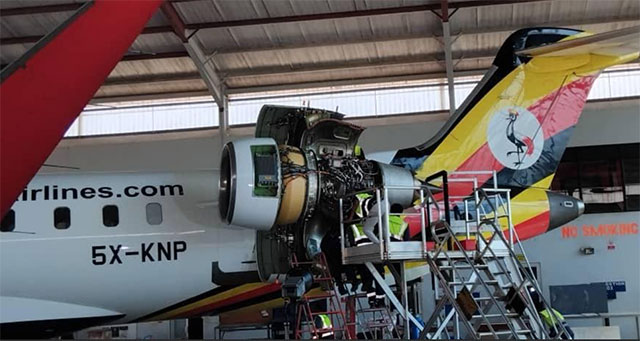By Fidel Boy Leon
Acquiring the aircraft was the first step. The true test of a national airline, however, lies in the complex, hands-on work of keeping it flying.
This past week, Uganda Airlines engineers met that challenge head-on, performing the first-ever in-house engine change on an A330.
Uganda Airlines’ Approved Maintenance Organisation (AMO) successfully performed its first-ever in-house engine replacement on a CRJ900 aircraft, registration 5X-KNP.
The achievement comes just days before the national carrier marks its sixth anniversary on August 28, 2025, underscoring its growing technical independence.
The operation involved removing the aircraft’s left engine (Engine 1) and installing a new General Electric CF34-8C5 unit. The replaced engine will be shipped to the manufacturer for scheduled modifications and later reinstalled on the opposite side, ensuring both engines undergo the necessary upgrades.
While engine changes are standard in global aviation, this was groundbreaking for Uganda Airlines, since it was the first conducted entirely by its AMO team since certification by the Uganda Civil Aviation Authority in March 2024.
“This is a milestone achievement for our airline, our country, and the region,” said Peter Emuge, Head of Maintenance and Engineering. Until now, such operations had to be outsourced abroad. “With our AMO, we can now handle top-level technical work locally, using Ugandan engineers.”
He explained that although an engine change typically takes 48 hours, extra time was allocated for this first attempt to give young engineers full hands-on learning.
Outsourcing such a job abroad would have cost over USD 100,000, excluding ferrying and handling expenses, while conducting it in Uganda saves the airline and country significant resources.
Though the AMO team includes internationally recruited specialists, Uganda Airlines has invested heavily in training local engineers.
Currently, 18 graduate trainees from Soroti Flying School and leading universities like Makerere University are undergoing mentorship, with the goal of attaining aircraft maintenance licences within three years.
“When Uganda Airlines restarted, some doubted whether Ugandans could handle such technical work,” said CEO Jenifer Bamuturaki. Today, our engineers have proven themselves. “We are nurturing the next generation of managers, pilots, and engineers, so this airline becomes fully Ugandan-led.”
According to Joseph Lukwago, Head of Line Maintenance, Uganda Airlines has slashed maintenance costs since taking over from Dutch firm SAMCO in August 2023.
“Previously, we spent between UGX 800 million and 1 billion monthly on outsourced maintenance. “By doing the work ourselves, we’ve reduced these costs significantly,” Lukwago explained.
Flying the aircraft abroad for the engine change alone would have cost USD 10,000 in fuel plus over USD 100,000 for the procedure.
He noted that about 45 staff members, including engineers, assistants, and trainees, are engaged in line maintenance, with women playing a notable role.
“This engine change included female engineers, a technical records officer, a materials’ manager, and a development engineer overseeing engines. It’s a milestone for gender inclusion in aviation,” he said.
The engine change symbolises broader progress for Uganda Airlines as it positions itself for long-term sustainability. Passenger numbers have grown from 70,000 in 2019 to more than 419,000 in the last financial year, pushing the cumulative total since relaunch to over 1.2 million.
“We started with just five flights daily in 2019,” Bamuturaki noted. Today, we operate nearly 59 flights a day, over 580 weekly. “Our cargo services are expanding, and our London route has been a breakthrough in revenue, recognition, and tourism promotion.”
Like many global carriers, Uganda Airlines faces supply chain challenges, particularly with spare parts. Emuge reassured the public that mitigation measures are in place, including predictive maintenance and supplier partnerships.
“The challenge is global, not unique to Uganda Airlines,” he said. Post-COVID demand outpaced production, causing delays and higher costs. But spare parts remain available for our GE-powered CRJ aircraft engines.”
Bamuturaki added: “Thanks to pre-ordered spare engines secured with government support, operations continue smoothly as engines rotate for maintenance. It is disappointing when Ugandans undermine their own airline. In other countries, citizens support their national carriers. I urge Ugandans to do the same, because our success benefits the entire economy.”
“Uganda Airlines is still young, but the strides we’ve made show what is possible,” Bamuturaki said. “We are building something that will serve generations to come.”


